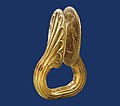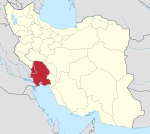Behbahan
Behbahan
Persian: بهبهان | |
|---|---|
City | |
 Ring of Power, the historical symbol of Behbahan | |
| Coordinates: 30°35′39″N 50°14′36″E / 30.59417°N 50.24333°E[1] | |
| Country | Iran |
| Province | Khuzestan |
| County | Behbahan |
| District | Central |
| Population (2016)[2] | |
| • Total | 122,604 |
| Time zone | UTC+3:30 (IRST) |
Behbahan (Persian: بهبهان)[a] is a city in the Central District of Behbahan County, Khuzestan province, Iran, serving as capital of both the county and the district.[4]
At the 2006 National Census, its population was 99,204 in 24,204 households.[5] The following census in 2011 counted 107,412 people in 29,280 households.[6] The latest census in 2016 showed a population of 122,604 people in 35,826 households.[2]
Etymology[edit]

The origin of word 'Behbahan' can be traced back to two distinct ideas. According to some scholars like Nowban[7], while the first part of the word, 'beh', means 'good', the latter, 'bahan', means palace or a very big house surrounded by orchards and gardens. This is well-documented that the region was an agricultural center/hub producing mainly olive, dates, citruses as well as flower gardens[8][9]. This means, the term Behbahan means a nice living area surrounded by gardens and farms.
Alternatively, it is suggested that the latter component of the word, namely 'bahan', might had been used to refer to a type of tent used in old times. In other words, after the downfall[10] of the ancient city of Arrajan due to a series of devastating earthquakes[11], survivors unsurprisingly had to live in tents for some time. As they started to reconstruct the city, the name 'Behbahan' was used to mean it is better than tents.[12] However, the use of the word 'beh' as 'better' rather than 'good' is rarely, if any, reported in Persian langauge[13]. Also, there is no actual document of people using 'bahan' tents after the above-mentioned earthquakes. Resultantly, there needs to be more research on the etymology of the word Behbahan.
History of Behbahan[edit]

History of Behbahan is indispensably intertwined with the ancient Iranian city of Argan (Arrajan) from Elamite era (3200–539 BC)[14][15]. During a dam construction project[16] on Marun river in 1982[17], an accidental[18] find was reported shocking local archeologists. It was identified as a neo-Elamite[19][20] tomb (600-550 BC)[21] of a noble person who later turned out to be the Elamite ruler[22] Kidin-Hutran[23] son of Kurlush[24]. The tomb contains a large bronze coffin[25] which had a golden ring of power[26], ninety-eight golden buttons[27], ten cylindrical vessels[28], a dagger, a silver bar, and a bronze tray[29] called Arjan bowl with various images[30] found with the coffin[31].
However, Arjan saw its downfall as it was hit by a series of earthquakes destroying almost all of its infrastructure. In the cross-road of Elamite and Persian empires, as claimed by Alvarez-Mon[32], the city had to be rebuilt.
The reconstruction was done by Kavadh I who was the Sasanian King of Kings[33] of Iran from 488 to 531, with a two or three-year interruption[34]. In 502-503[35], the king launched a campaign as part of the Anastasian War against northern Roman Mesopotamia[36], and deported 80,000 prisoners from Amida, Theodosiopolis, and possibly Martyropolis to Pars, some of whom are thought to have helped rebuild the city of Arrajan[37]. This is why the names 'Ram-Qobad', 'Beram-Qobad', 'Abar-Qobad' and 'Beh az Amed-e Kavad'[32] all used by later historians to refer to the reconstructed Arjan, include an elemet referring to king Kavad I[38].
Through time, Arrajan experienced ups and downs of the history and managed to survive even the Arab Muslim invasion albeit at the cost of almost all residents having to convert from Zoroasterianism to Islam. The name, as discussed above, was changed to Behbahan in the Islamic period.
Gallery[edit]
-
A replica of Arjan bowl
-
Ring of Power Statue, Symbol of Ancient Behbahan (Arjan Square)
-
Ruins of Arjan Briges on Marun River in Northern Behbahan
-
Arjan Ring of Power from Elamite king Kidin-Hutran
-
Marun Dam Public Resort
-
An outpost from Sassanid Era near Borj village, Behbahan
-
Main souvenir of Behbahan, daffodils
-
Bowl of Arjan
-
Ruins of Arjan town walls in northern Behbahan
-
1950s map of Behbahan
-
Ruins of a Nestorian church in Tashan village, Behbahan
-
Coin of either Hormizd V or Hormizd VI, minted in Veh-az-Amid-Kavād (present-day Behbahan)
Climate[edit]
Behbahan has a hot semi-arid climate (Köppen: BSh), characterised by sweltering and rainless summers and pleasant winters with occasional heavy rainfall.
| Climate data for Behbahan (1991-2021) | |||||||||||||
|---|---|---|---|---|---|---|---|---|---|---|---|---|---|
| Month | Jan | Feb | Mar | Apr | May | Jun | Jul | Aug | Sep | Oct | Nov | Dec | Year |
| Mean daily maximum °C (°F) | 16.7 (62.1) |
18.9 (66.0) |
24.4 (75.9) |
30.5 (86.9) |
38.2 (100.8) |
42.9 (109.2) |
44.3 (111.7) |
44.1 (111.4) |
40.3 (104.5) |
34.6 (94.3) |
24.2 (75.6) |
18.5 (65.3) |
31.5 (88.6) |
| Mean daily minimum °C (°F) | 6.0 (42.8) |
7.2 (45.0) |
10.5 (50.9) |
15.5 (59.9) |
21.1 (70.0) |
25.4 (77.7) |
28.2 (82.8) |
27.9 (82.2) |
23.9 (75.0) |
19.2 (66.6) |
12.6 (54.7) |
7.9 (46.2) |
17.1 (62.8) |
| Average rainfall mm (inches) | 117 (4.6) |
75 (3.0) |
69 (2.7) |
28 (1.1) |
6 (0.2) |
0 (0) |
0 (0) |
1 (0.0) |
1 (0.0) |
5 (0.2) |
74 (2.9) |
116 (4.6) |
492 (19.3) |
| Source: Climate-data.org | |||||||||||||
See also[edit]
Notes[edit]
References[edit]
- ^ OpenStreetMap contributors (27 July 2023). "Behbahan, Behbahan County" (Map). OpenStreetMap. Retrieved 27 July 2023.
- ^ a b "Census of the Islamic Republic of Iran, 1395 (2016)". AMAR (in Persian). The Statistical Center of Iran. p. 06. Archived from the original (Excel) on 21 October 2020. Retrieved 19 December 2022.
- ^ Behbahan can be found at GEOnet Names Server, at this link, by opening the Advanced Search box, entering "-3055917" in the "Unique Feature Id" form, and clicking on "Search Database".
- ^ Habibi, Hassan. "Approval of the organization and chain of citizenship of the elements and units of the national divisions of Khuzestan province, centered in the city of Ahvaz". Islamic Parliament Research Center (in Persian). Ministry of Interior, Political and Defense Commission of the Government Board. Archived from the original on 17 July 2014. Retrieved 25 January 2024.
- ^ "Census of the Islamic Republic of Iran, 1385 (2006)". AMAR (in Persian). The Statistical Center of Iran. p. 06. Archived from the original (Excel) on 20 September 2011. Retrieved 25 September 2022.
- ^ "Census of the Islamic Republic of Iran, 1390 (2011)". Syracuse University (in Persian). The Statistical Center of Iran. p. 06. Archived from the original (Excel) on 18 January 2023. Retrieved 19 December 2022.
- ^ Nowban, Mehrozaman (1998). Names of Geographical Places across Time (in Persian). Mah. p. 118. ISBN 964-6497-00-4.
- ^ Qubadiani-Balkhi, Naser Khosrow (2007). Vazinpour, Nader (ed.). Book of Travels (in Persian) (10th ed.). Tehran: Amirkabir.
- ^ "گنجور » ناصرخسرو » سفرنامه » بخش ۹۲ - ارجان". ganjoor.net. Retrieved 31 May 2024.
- ^ Iranica Encyclopedia. "Arrjan". Encyclopedia Iranica. Retrieved 31 May 2024.
- ^ Ebn-e Athir, Ezzoddin (2005). The Full History (in Persian). Translated by Roohani, Hossein (3rd ed.). Tehran: Asatir.
- ^ "Meaning of Behbahan - معنى بهبهان". 14 July 2011. Archived from the original on 14 July 2011. Retrieved 6 February 2021.
- ^ Dehkhoda, Ali Akbar (2007). Dehkhoda Dictionary of Persian Language (in Persian). Tehran: Tehran University Publications. ISBN 964-0393851.
- ^ "Historical mansion in Behbahan to turn into handicrafts center". Tehran Times. 21 June 2023. Retrieved 31 May 2024.
- ^ "BEHBAHAN". referenceworks. Retrieved 31 May 2024.
- ^ زارع, بابک (30 July 2021). "گنجینه ارجان". تاریخ ما (in Persian). Retrieved 31 May 2024.
- ^ "داستانِ اشتباهی که در هدیهی تاریخی بهبهانیها به المپیک توکیو رخ داد". ایسنا (in Persian). 12 December 2020. Retrieved 31 May 2024.
- ^ جهان, Fararu | فرارو | اخبار روز ایران و (۱۴۰۲/۰۳/۱۴ - ۱۷:۴۶). "پنج گنج بزرگ ایرانی که به طور اتفاقی کشف شدند". fa (in Persian). Retrieved 2024-05-31.
{{cite web}}: Check date values in:|date=(help) - ^ Vallat, Francois (1884). "Kidin-Hutran et l'epoque néo-élamite". Akkadica (in French) (37): 1–17.
- ^ Alizadeh, Abbas (1985). "A Tomb of the Neo-Elamite Period at Arjan, Near Behbahan". Archaologische Mitteilungen aus Iran und Turan (18): 49–73.
- ^ "Peeters Publishers Leuven". www.peeters-leuven.be. Retrieved 31 May 2024.
- ^ "On the Antiquity of the Yurt: Evidence from Arjan and Elsewhere". www.silkroadfoundation.org. Retrieved 1 June 2024.
- ^ محمد, آزغ (1395-11-05). "ارجان شهری متعلق به دوره ی ساسانی یا عیلامی" (in Farsi). اولین کنفرانس سالانه پژوهش های معماری، شهرسازی و مدیریت شهری.
{{cite journal}}: Check date values in:|date=(help); Cite journal requires|journal=(help)CS1 maint: unrecognized language (link) - ^ Wicks, Yasmina. Potts, D.T. (ed.). The Encyclopedia of Ancient History. United States: John Wiley & Sons Inc. pp. 1–5. ISBN 1119399912.
- ^ "در مورد ارجان در ویکی تابناک بیشتر بخوانید". www.tabnak.ir. Retrieved 31 May 2024.
- ^ admina (29 July 2023). "حلقه قدرت، شاهکار زرّین هنر ایرانی". مدار گشت زمین (in Persian). Retrieved 31 May 2024.
- ^ Vatandust, R. (1988). "A Preliminary Report on the Conservation and Technical Studies of Some of the Arjan Material". Asar (in Persian) (16): 72–116.
- ^ زارع, بابک (30 July 2021). "گنجینه ارجان". تاریخ ما (in Persian). Retrieved 31 May 2024.
- ^ "داستانِ اشتباهی که در هدیهی تاریخی بهبهانیها به المپیک توکیو رخ داد". ایسنا (in Persian). 12 December 2020. Retrieved 31 May 2024.
- ^ Alvarez-Mon, Javier (2022). "Between Picasso and Piradi On tour with Saltimbanques and Musicians from ancient Iran (ca. 600 BC)". Journal of Iran National Museum. 2 (1): 129–140.
- ^ ایران, عصر (۱۳۹۹/۰۴/۰۷ - ۰۰:۱۵). "داستان حلقه رازآمیز پادشاه / تابوتی که همه را شگفتزده کرد (فیلم)". fa (in Persian). Retrieved 2024-05-31.
{{cite web}}: Check date values in:|date=(help) - ^ a b Alvarez-Mon, Javier (2010). The Arjan Tomb: At the Crossroads of the Elamite and the Persian Empires. Peeters. ISBN 9789042922006.
- ^ Tyler-Smith, Susan. "The Kavād Hoard". The Numismatic Chronicle. 164: 308–312.
- ^ "Kavadh I | Sasanian Dynasty, Zoroastrianism & Revolt | Britannica". www.britannica.com. Retrieved 1 June 2024.
- ^ "Kavad I - Livius". www.livius.org. Retrieved 1 June 2024.
- ^ "Kavadh I | Sasanian Dynasty, Zoroastrianism & Revolt | Britannica". www.britannica.com. Retrieved 1 June 2024.
- ^ profilbaru.com. "Amida (Mesopotamia)". Retrieved 1 June 2024.
- ^ Kavir, Mahmood (2017). The Phoenix Millennium: from the Sassanid to the Samanid (in Persian). London: H & S Media.
External links[edit]
















